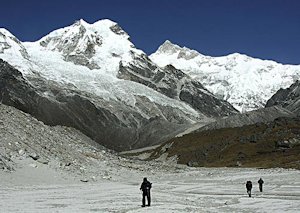Rethinking AGW, Part 8: The IPCC
 | | The Himalayas |
Just north of India, forming a formidable barrier between it and the rest of Asia, two techtonic plates are slowly colliding with each other and building the world's highest landmarks. It is hard to overstate the importance of the Himalaya mountain range, which is the only thing that stopped Genghis Khan from conquering the known world. Its awesome majesty has become of critical importance to many of the world's most enduring religions, including Hinduism, Sikhism, and Buddhism, and its unique combination of intense altitude and climate have given birth to some of the most fascinating extremophile organisms ever observed. Many of the world's major river systems originate here, and nearly half of all living human beings flourish within their drainage basins, most of them relying in one way or another on the mountain range's glacier systems for their survival. It was therefore immensely alarming when the IPCC, the International Panel on Climate Change, concluded in one of its recent reports that, due to global warming, the glaciers will be gone by 2035.
When it comes to the scientific basis for public policy concerning AGW (anthropogenic global warming), it is hard to have any kind of conversation on the matter without talking about the IPCC, a scientific body established within the framework of the United Nations that is charged with assessing the state of the scientific data when it comes to "human-induced climate change," its impacts, and "options for adaptation and mitigation." The IPCC's periodic assessment reports are the go-to resource for advocates and politicians, and the conclusions reached within are usually considered reliable and above reproach. However, not long after being awarded the 2007 Nobel Peace Prize (along with Al Gore), a glaring error in its latest report was discovered, leading to a flood of charges that the reports may be innacurate, that some of its lead authors face serious conflicts of interest, and that the political nature of the IPCC itself may render its authoritative scientific reputation null and void. This error, you might have guessed, concerns the conclusion that the Himalayan glaciers will disappear by 2035, a bit of terrifying news that is blessedly untrue.
In order to determine whether the IPCC is a trustworthy source of information about AGW, we should probably look at how the IPCC was created and how it functions before we start rendering hasty generalizations on the basis of one highly visible error. In the spirit of this exercise, I'm going to start with the assumption that those working on the IPCC have noble intentions, and I will be highly dubious of any criticism that presupposes some kind of behind-the-scenes conspiracy motivated by either political power or profit. Having said that, I will consider the specter of unintentional confirmation bias as well as the possibility that some members of the IPCC are working in poor faith (though not conspiratorially).
 | | Al Gore and IPCC chairman Rajendra Pachauri accepting the Nobel Peace Prize |
The way the IPCC works is that hundreds if not thousands of scientists--who are not funded by the IPCC--devote their own time to organizing the existing data and sending the fruits of their labor to the panel. The data is taken from peer-reviewed and internationally available literature (including gray literature), which means that the IPCC does not create any science of its own; the IPCC does not conduct research or do any original data collection. In order to understand what the IPCC actually does, then, we can consult the IPCC's own literature:
The IPCC is an intergovernmental body, sponsored by UNEP and WMO, that is open to all member countries of the United Nations and the WMO. Each government has an IPCC focal point who coordinates IPCC-related activities in the country. Major decisions about the IPCC structure and work, such as reports and their scope, are taken by the Panel, which meets in Plenary Sessions at the level of government representatives approximately once a year. One of the responsibilities of the Panel is to elect the IPCC Chair, the Working Group and Task Force Co-Chairs and other members of the IPCC Bureau.
If that seems like a mouthful, the bottom line is that the IPCC is funded, organized, and operated by international bureaucracy, by well over a hundred separate governments from around the world working cooperatively. Though most of the work is done by independent scientists, the enormous amount of data is parsed, arranged, proofread, and approved by bureaucrats.
To be fair, that's a bit simplistic. The information sent to the IPCC goes through a much more complex process. Again, according to the IPCC itself:
Hundreds of the world’s top scientists work to develop the IPCC Assessment Reports through critically analyzing and synthesizing the best scientific, technical and socio-economic information available in peer-reviewed and internationally available literature. Their findings are then extensively reviewed by an independent stet of scientists and then, after revision, by a wide range of interested parties. Experts in interpreting scientific matters for government leaders work with the scientific authors to carefully and effectively convey this information to policy-makers.
It doesn't end there. The information is then filtered through either the IPCC's Task Force on National Greenhouse Gas Inventories or through one of its three Working Groups, where it is organized into early drafts of the assessent reports. These drafts "go through an extensive, multi-level review process. Reviewers typically represent more than 150 countries as well as a wide range of public and private sector organizations."
As the IPCC helpfully elaborates:
Because the IPCC is an intergovernmental body, IPCC reports are reviewed by governments as well as experts. As drafts are prepared and finalized, comments received from both are taken into account by lead authors.
 | | "Requisition me a beat." - Hermes Conrad |
Bureaucracy is not, by itself, a bad thing. In fact, science itself works under its own set of bureaucratic rules and realities, if for no other reason than to economize funding and organize the publication and peer review process. However, the data being sent to the IPCC has already gone through this process, has already been subject to the vagaries of questionable authorities and publication bias. For it to then be passed through thousands upon thousands of politically-motivated hands only serves to amplify and exacerbate the potential prejudices. Therefore, it is incredibly difficult to accept the end results of the IPCC process, the much lauded assessment reports, as untainted, scientific gospel.
This is not to say that those involved in the process are deliberately misrepresenting the facts as they understand them. I am more than happy to believe that the vast majority of these people is operating in good faith and with the best of intentions. AGW is a dense, complex, and serious subject that is very hard to distill for a lay audience, as this entire exercise of mine has already illustrated. Since it is also a potentially critical problem for the entire human race, it is absolutely essential to get the information to the people in charge of public policy, people who rarely are scientifically literate. Now that AGW is well-known, politicians are going to address it, regardless of whether they understand it, so something like the IPCC is the inevitable attempt to help them. Unfortunately, good intentions don't always translate to good results.
Which brings us back to the Himalayas. The idea, published as part of the IPCC's Fourth Assessment Report, that the mountains will dry up in the next twenty years or so is not only false, but it is also based on the most indefensible of wild speculations.
What the report (specifically, chapter 10 of the Working Group II report) actually says is that "Glaciers in the Himalaya are receding faster than in any other part of the world and, if the present rate continues, the likelihood of them disappearing by the year 2035 and perhaps sooner is very high if the Earth keeps warming at the current rate. Its total area will likely shrink from the present 500,000 to 100,000 km^2 by the year 2035." The 2035 disappearance date is cited from a World Wildlife Fund report which is itself citing an issue of New Scientist. In the New Scientist article, Syed Hasnain, Chairman of the International Commission for Snow and Ice, is quoted from an e-mail interview arguing that most of the Himalayan glaciers "will vanish within 40 years," a rough estimate not found in Hasnain's subesquent study. What's even worse is that the second part of the report's assertion--that the total area of Hamalayan ice "will likely shrink from the present 500,000 to 100,000 km^2"--is just as obviously and demonstrably untrue, as the glaciers currently cover 33,000 km^2. If this is data that has been published, peer-reviewed, and gone through the IPCC's supposedly airtight process, it should be disheartening to the faithful that not one of the thousands of people involved did any basic fact checking.
 | | At least the interns have something to do now |
Sure, the Himalaya data could just be an honest mistake, but it does reveal a potentially endemic problem with the IPCC's process, a reality that even the IPCC has acknowledged. Indeed, other potential inaccuracies have popped up, including African crop yield projections that originate with a non-peer-reviewed Canadian think tank and an assertion that 55% of the Netherlands is under sea level (it's actually closer to 26%). Others have raised concerns about the process itself, pointing to things like the fact that the IPCC chairman, Rajendra Pachauri, also directs the Energy and Resources Institute in New Delhi, which has clear ties to businesses that would stand to make a profit from climate policy. Call me cynical, but I imagine the bureaucratic response to these snafus will be to add more bureaucracy.
The saddest part of this analysis is that, despite being highly critical of the IPCC, it still leaves room for AGW to be a real threat. Indeed, many scientists are vehement that, despite the handful of obvious problems with IPCC reports, the bulk of the data and conclusions reached remains largely unquestioned. However, given my reservations with where the most basic data originates, the reality of publication bias, the insidious influence of politics, and the muddling effects of intergovernmental agencies, I am unwilling to make any blanket assumptions about AGW one way or another. If AGW is real, then, it is depressing to know how thoroughly the scientific process has been polluted by overeager passions and subtle prejudices. I can sense I'm approaching the end of this exercise, because one conclusion keeps making itself abundantly apparent: certainty is unwarranted.
-e. magill 6/12/2012
|
|